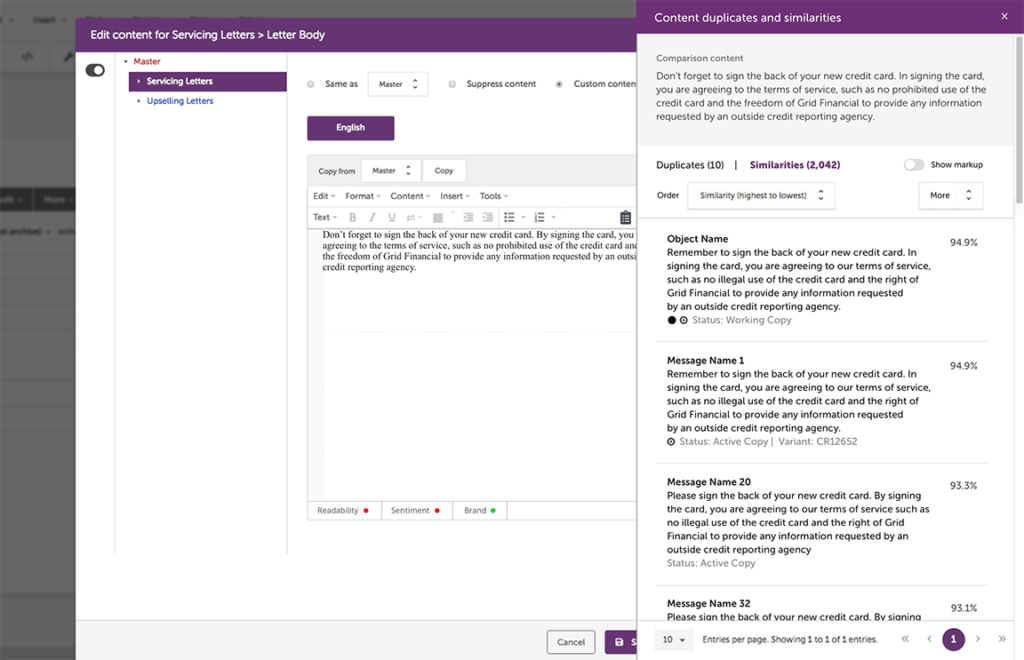
Creating and managing content is no easy task, particularly when many individuals and groups across an organization create their own. Across any business, the same base content is often written and re-written repeatedly. This is a costly process—not just in money and time wasted on redundant work, but in the loss of consistency with every iteration.
In this era of digital transformation, consistency is even harder to achieve. Organizations are creating operational silos along communication channels, resulting in similar content being authored, maintained, and managed in many places. This not only fragments the message and brand but also degrades the customer experience.
Many companies take on a manual program to analyze and “clean up” their content inventories, but these projects are not only costly, time-consuming and subject to human error, they are also rarely comprehensive. A different approach is required—one that’s not only capable of ingesting legacy and digital content from all sources, but takes an automated approach to the analysis and doing away with a manual approach. Many aspects of the content should be examined, including the existence of both duplicate content and similar content with inconsistencies, alignment with brand guidelines, reading comprehension levels, and sentiment.
Finding duplicates and similarities in your content inventory
Most content systems can conduct some form of search to find exact duplicates—even Microsoft Word has this function. This is helpful when you know everyone in your organization is using the exact same content. Unfortunately, when dealing with content that evolves over time or varies across groups and channels, this is rarely useful. A system needs to be able to pick up subtle variations in order to keep your messaging and brand consistent.
Artificial Intelligence (AI) has provided the opportunity to address this issue in an effective and efficient manner at scale. By leveraging AI-powered Content Intelligence capabilities to analyze a corpus of communications, not only will you be able to find duplicates—you’ll be able to find the similarities, too.
Let’s look at some examples of subtle variations that the AI-powered Messagepoint Advanced Rationalization and Content Intelligence Engine (MARCIE) reveals.
The last payment of $140.27 was not received. If this payment is not made by May 5th, 2020, your insurance coverage may not continue.
This is the original, correct content that should appear in all customer communications of this kind. However, it is easy to see where this kind of content can be altered in such a way as to make redundant similarities or drastically change the meaning of the message.
The last payment of $140.27 was not received, and if this payment is not made by May 5th, 2020, your insurance coverage may not continue. [OPP FOR CONSOLIDATION, 98.6%]
In this example, the message has changed from two sentences to one, joined by “and”. This is an example of content that can be consolidated, centrally managed and shared to unnecessary duplication and ensure consistency.
The last payment of $140.27 was not received. If this payment is not made by May 5th 2020 your insurance coverage may not continue. [FORMAT CHANGES, *100%]
In this subtle change, there is no comma after the date.
The last payment of $140.27 was not received. If this payment is not made by May 5th, 2020, your insurance coverage will not continue. [MEANING DIFFERENCE, 97.1%]
Here the change is in meaning – “your insurance may not continue” versus “your insurance will not continue”. The use of will is more threatening and doesn’t reflect the tone the organization wishes to take at this point with the customer.
The last payment of $140.27 was received. If the next payment is not made by May 5th, 2020, your insurance coverage may not continue. [MEANING DIFFERENCE, 94.2%]
This change is again simple and easily missed – now the message being conveyed is a confirmation of a received payment, as well as a reminder of the next.
The last payment of $140.27 was received. If this payment is not made by May 5th, 2020, your insurance coverage may not continue. [MISSING INFORMATION, 98.8%]
Here, a missing “not” has rendered the entire message meaningless and leads to confusion and potentially missed payments in the future. These kinds of alterations might seem simple and inconsequential, but they are the very changes that make the difference between an excellent communication, and one that violates brand standards or even legal requirements.
In the examples above, it’s relatively easy to spot major differences immediately. But what about structural changes? Oxford commas? What about possible extra spaces, or small differences in English spelling? What about when we change the sample size of the content from simple statements in these examples to longer paragraphs, full documents. And how about when we have to analyze hundreds of thousands of those?
Even examining these two paragraphs is challenging:
This is a notice of missed payment. We did not receive your payment of $140.27 on April 25th, 2020. If we do not receive a payment by May 5th, 2020, your insurance coverage may not continue. Keep in mind that any damages that may occur in times of lapsed insurance coverage are the responsibility of the vehicle owner and solely the vehicle owner. As such, the Company will not process any claims during these times. For further information on coverage or how to make your payments, please contact us at 123.456.7890. Our offices are open from 9:00am-5:00pm EST Monday to Friday. (100%)
This is a notice of a missed payment – we failed to receive your payment of $140.27 on April 25th, 2020. If we do not receive a payment by May 5th, 2020 your insurance coverage may not continue. Keep in mind that any damages that occur in times of lapsed insurance coverage are the responsibility of the vehicle owner and solely the owner. As such, the Company will not process any insurance claims during these times. For further information on coverage or methods of payments please contact us at 123-456-7890. Our offices are open from 9:00a.m.-5:00p.m. EST Monday to Friday. (94.9%)
In addition, advanced visualizations of your content and associated data helps you identify areas of priority. In the screenshot below from Messagepoint Rationalizer, we can see MARCIE found opportunities to consolidate content and share content, thereby creating a consistent message.

Taking an automated, AI-powered approach to finding duplicates and similar content for consolidation can take the clean-up effort down from months to days. This not only accelerates your project but can be a key enabler of platform migration and digital transformation initiatives by cleaning up and preparing content for modern channels and even channels of the future.
Learn more about other aspects of your communications that can and should be part of a clean-up effort—including alignment with brand guidelines, reading comprehension levels and sentiment.

TORONTO, December 5, 2024 – Messagepoint Inc. announced it has been named a Leader in the IDC MarketScape:…
Read more
IDC’s MarketScape for Intelligent Customer Communications Management evaluates vendors that natively own or integrate forms technology and artificial…
Read the whitepaper
The mortgage servicing industry is under immense financial pressure. With interest rates high and home prices still rising,…
Read the Article